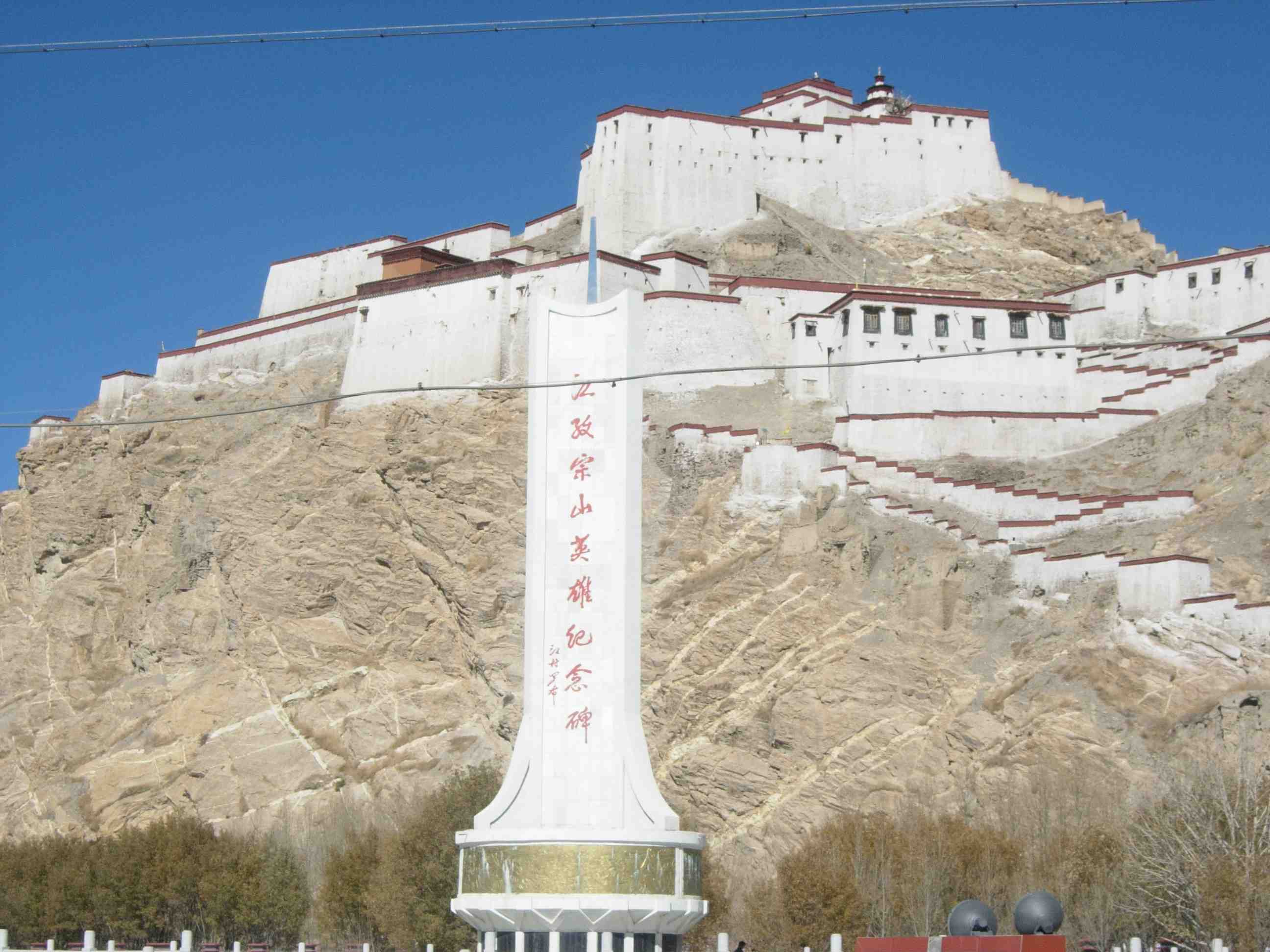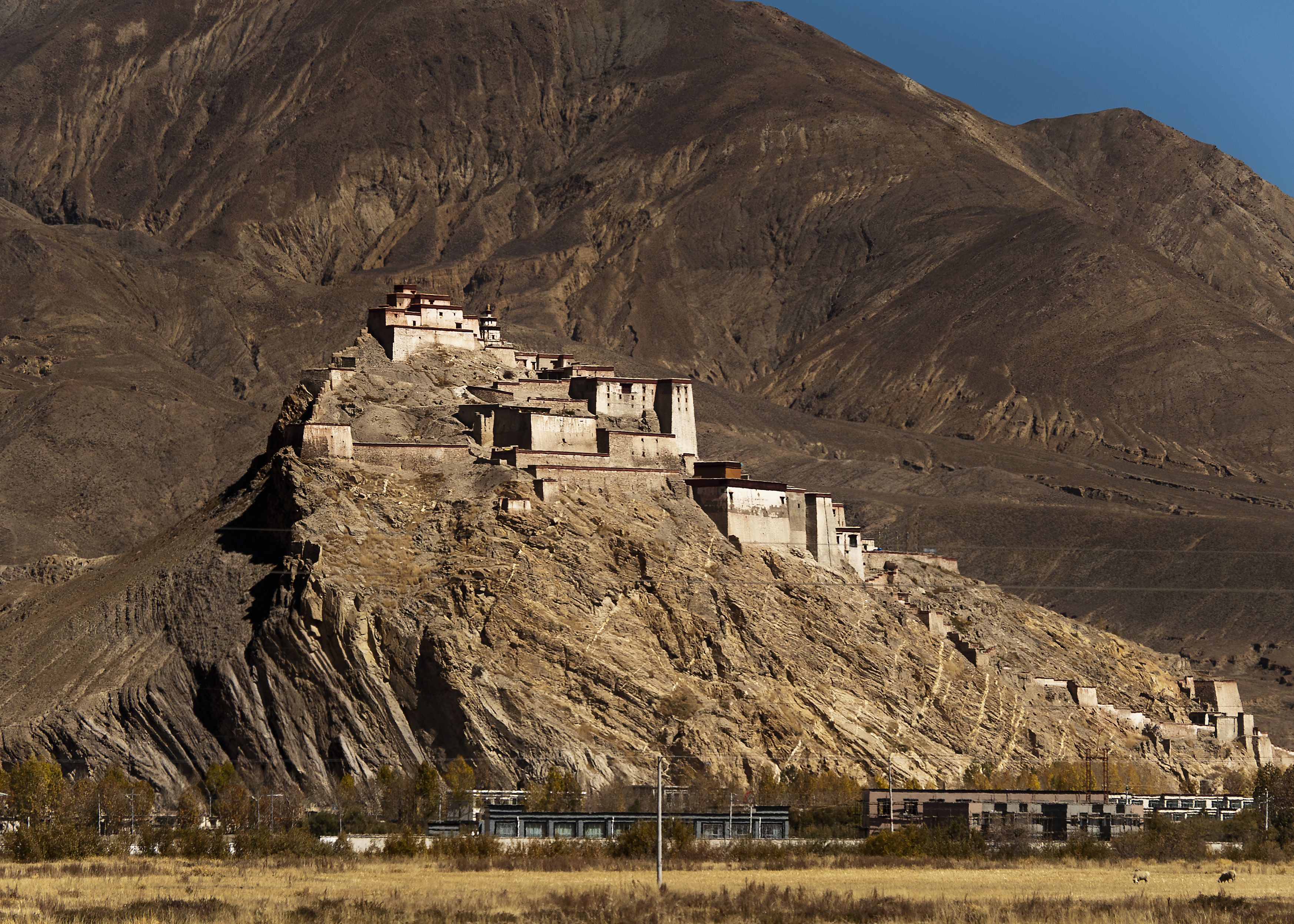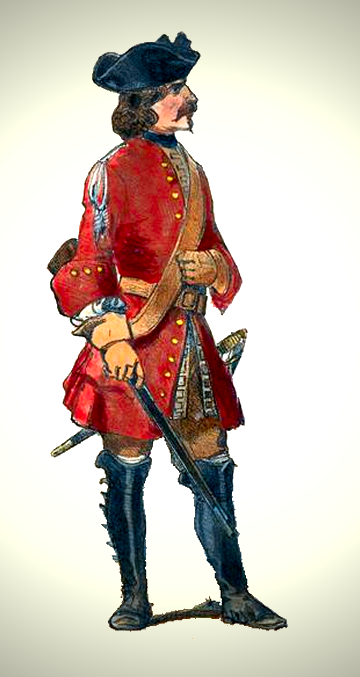|
Gyantse Dzong
Gyantse Dzong or Gyantse Fortress is one of the best preserved dzongs in Tibet, perched high above the town of Gyantse on a huge spur of grey brown rock.French (1994), p. 227. According to Vitali, the fortress was constructed in 1390 and guarded the southern approaches to the Tsangpo Valley and Lhasa. The town was surrounded by a wall long.Buckley, Michael and Strauss, Robert (1986), p. 158. The entrance is on the eastern side. Early history The original fortress, known as Gyel-khar-tse was attributed to Pelkhor-tsen, son of the anti-Buddhist king Langdharma, who probably reigned from 838 to 841 CE. The present walls were supposedly built in 1268, after the rise in power of the Sakyapa sect. A large palace was built in 1365 by a local prince, Phakpa Pelzangpo (1318–1370), who had found favour campaigning for the Sakyapas in the south. He also brought a famous Buddhist teacher, Buton Rinchendrub of Zhalu, to live in a temple there. Later in the 14th century Phakpa Pelzang ... [...More Info...] [...Related Items...] OR: [Wikipedia] [Google] [Baidu] |
Dzong Architecture
Dzong architecture is used for dzongs, a distinctive type of fortified monastery (, , ) architecture found mainly in Bhutan and Tibet. The architecture is massive in style with towering exterior walls surrounding a complex of courtyards, temples, administrative offices, and monks' accommodation. Characteristics Distinctive features include: * High inward sloping walls of brick and stone painted white with few or no windows in the lower sections of the wall * Use of a surrounding red ochre stripe near the top of the walls, sometimes punctuated by large gold circles * Use of unique style flared roofs atop interior temples * Massive entry doors made of wood and iron * Interior courtyards and temples brightly colored in Buddhist-themed art motifs such as the ashtamangala or swastika Regional differences Bhutan Dzongs serve as the religious, military, administrative, and social centers of their district. They are often the site of an annual '' tsechu'' or religious festival. Typica ... [...More Info...] [...Related Items...] OR: [Wikipedia] [Google] [Baidu] |
James Macdonald (engineer)
Major General Sir James Ronald Leslie Macdonald, (8 February 1862 – 27 June 1927) was a British engineer, explorer, military officer and cartographer. Born in the Madras Presidency, he was a balloon observer as a young man, surveyed for railways in British India and East Africa, explored the upper Nile region, commanded balloon sections during the Second Boer War and Boxer Rebellion and led the British expedition to Tibet in 1903–1904. Early career Macdonald was born on 8 February 1862 in Rajahmundry in the Madras Presidency, India, the son of Surgeon-Major James Macdonald (1828–1906) of Aberdeen and Margaret Helen Leslie ''née'' Collie (1841–1876); his younger sister was the Egyptologist and archaeologist Nora Griffith. He was educated at Aberdeen Grammar School and the University of Aberdeen. He passed through the Royal Military Academy, Woolwich and was gazetted as a lieutenant to the Royal Engineers in February 1882. As a lieutenant, on 15 May 1885, Macdonald wa ... [...More Info...] [...Related Items...] OR: [Wikipedia] [Google] [Baidu] |
Tsechen Monastery And Dzong
Tsechen Monastery (also known as the Tsechen Dzong or the Shambu Tsegu) was a Tibetan monastery located approximately northwest of Gyantse. It was one of the largest of the fortified monasteries constructed in Tibet, and was located above a village also known as Tsechen. Constructed "on another precipitous hill about 600 feet high, about one mile long, and rising abruptly out of the plain", the monastery was similar to the Gyantse Dzong in terms of the strength of its fortifications. During the 1904 British expedition to Tibet by Colonel Francis Younghusband, the monastery was occupied by Tibetan troops, which used it to resist the expedition's advance. Younghusband's forces captured the monastery and sacked and burnt it; some of the hilltop walls are all that remain of the structure. Early history It was founded by Nyawon Kunga Pel (1285 - 1379) in 1366, under the sponsorship of Prince Phakpa Pelzangpo (1318-1370 CE), Gyantse's first prince. Nyawon Kunga Pel gave teachings to ... [...More Info...] [...Related Items...] OR: [Wikipedia] [Google] [Baidu] |
Mule
The mule is a domestic equine hybrid between a donkey, and a horse. It is the offspring of a male donkey (a jack) and a female horse (a mare). The horse and the donkey are different species, with different numbers of chromosomes; of the two possible first-generation hybrids between them, the mule is easier to obtain and more common than the hinny, which is the offspring of a male horse (a stallion) and a female donkey (a jenny). Mules vary widely in size, and may be of any color seen in horses or donkeys. They are more patient, hardier and longer-lived than horses, and are perceived as less obstinate and more intelligent than donkeys. Terminology A female mule is often called a "molly" or "Molly mule," though the correct term is "mare mule." A male mule is called a "john" or "John mule," though the correct term is "horse mule." A young male mule is called a "mule colt," and a young female is called a "mule filly." The donkey used to produce mules is called a "mule ja ... [...More Info...] [...Related Items...] OR: [Wikipedia] [Google] [Baidu] |
Mounted Infantry
Mounted infantry were infantry who rode horses instead of marching. Unlike cavalry, mounted infantry dismounted to fight on foot. The original dragoons were essentially mounted infantry. According to the ''Encyclopædia Britannica Eleventh Edition'' (1910–1911), "Mounted rifles are half cavalry, mounted infantry merely specially mobile infantry." Today, with motor vehicles having replaced horses for military transport, the motorized infantry are in some respects successors to mounted infantry. History Pre-gunpowder The origins of mounted infantry go back to at least the beginnings of organised warfare. With the weight of ancient bronze Body armor, armor, the opposing Champion warfare, champions would travel to battle on chariots before dismounting to fight. With the evolution of hoplite warfare, some hoplites would travel to battle on horseback, before dismounting to take their place in the phalanx. The early pre-Gaius Marius, Marian Military of ancient Rome, Roman military had ... [...More Info...] [...Related Items...] OR: [Wikipedia] [Google] [Baidu] |
British Raj
The British Raj ( ; from Hindustani language, Hindustani , 'reign', 'rule' or 'government') was the colonial rule of the British The Crown, Crown on the Indian subcontinent, * * lasting from 1858 to 1947. * * It is also called Crown rule in India, * * * * or direct rule in India. * Quote: "Mill, who was himself employed by the British East India company from the age of seventeen until the British government assumed direct rule over India in 1858." * * The region under British control was commonly called India in contemporaneous usage and included areas directly administered by the United Kingdom of Great Britain and Ireland, United Kingdom, which were collectively called ''Presidencies and provinces of British India, British India'', and areas ruled by indigenous rulers, but under British British paramountcy, paramountcy, called the princely states. The region was sometimes called the Indian Empire, though not officially. As ''India'', it was a founding member of th ... [...More Info...] [...Related Items...] OR: [Wikipedia] [Google] [Baidu] |
Espionage
Espionage, spying, or intelligence gathering, as a subfield of the intelligence field, is the act of obtaining secret or confidential information ( intelligence). A person who commits espionage on a mission-specific contract is called an ''espionage agent'' or ''spy''. A person who commits espionage as a fully employed officer of a government is called an intelligence officer. Any individual or spy ring (a cooperating group of spies), in the service of a government, company, criminal organization, or independent operation, can commit espionage. The practice is clandestine, as it is by definition unwelcome. In some circumstances, it may be a legal tool of law enforcement and in others, it may be illegal and punishable by law. Espionage is often part of an institutional effort by a government or commercial concern. However, the term tends to be associated with state spying on potential or actual enemies for military purposes. Spying involving corporations is known as c ... [...More Info...] [...Related Items...] OR: [Wikipedia] [Google] [Baidu] |
13th Dalai Lama
The 13th Dalai Lama, Thubten Gyatso (full given name: Ngawang Lobsang Thupten Gyatso Jigdral Chokley Namgyal; abbreviated to Thubten Gyatso) (; 12 February 1876 – 17 December 1933) was the 13th Dalai Lama of Tibet, enthroned during a turbulent modern era. He presided during the collapse of the Qing dynasty, and is referred to as "the Great Thirteenth", responsible for redeclaring Tibet's national independence, and for his national reform and modernization initiatives. In 1878, he was recognized as the reincarnation of the Dalai Lama. He was escorted to Lhasa and given his pre-novice vows by the Panchen Lama, Tenpai Wangchuk, and given the name "Ngawang Lobsang Thupten Gyatso Jigdral Chokley Namgyal". In 1879, he was enthroned at the Potala Palace, but did not assume political power until 1895, after he had reached his maturity. Thubten Gyatso was an intellectual reformer and skillful politician. He was responsible for rebuilding Tibet's geopolitical position after the Brit ... [...More Info...] [...Related Items...] OR: [Wikipedia] [Google] [Baidu] |
Russian Empire
The Russian Empire was an empire that spanned most of northern Eurasia from its establishment in November 1721 until the proclamation of the Russian Republic in September 1917. At its height in the late 19th century, it covered about , roughly one-sixth of the world's landmass, making it the list of largest empires, third-largest empire in history, behind only the British Empire, British and Mongol Empire, Mongol empires. It also Russian colonization of North America, colonized Alaska between 1799 and 1867. The empire's 1897 census, the only one it conducted, found a population of 125.6 million with considerable ethnic, linguistic, religious, and socioeconomic diversity. From the 10th to 17th centuries, the Russians had been ruled by a noble class known as the boyars, above whom was the tsar, an absolute monarch. The groundwork of the Russian Empire was laid by Ivan III (), who greatly expanded his domain, established a centralized Russian national state, and secured inde ... [...More Info...] [...Related Items...] OR: [Wikipedia] [Google] [Baidu] |
Lake Baikal
Lake Baikal is a rift lake and the deepest lake in the world. It is situated in southern Siberia, Russia between the Federal subjects of Russia, federal subjects of Irkutsk Oblast, Irkutsk Oblasts of Russia, Oblast to the northwest and the Republic of Buryatia to the southeast. At —slightly larger than Belgium—Lake Baikal is the world's List of lakes by area, seventh-largest lake by surface area, as well as the second largest lake in Eurasia after the Caspian Sea. However, because it is also the List of lakes by depth, deepest lake, with a maximum depth of , Lake Baikal is the world's List of lakes by volume, largest freshwater lake by volume, containing of water or 22–23% of the world's fresh surface water, more than all of the North American Great Lakes combined. It is also the world's ancient lake, oldest lake at 25–30 million years, and among the clearest. It is estimated that the lake contains around 19% of the unfrozen fresh water on the planet. Lake Baikal ... [...More Info...] [...Related Items...] OR: [Wikipedia] [Google] [Baidu] |
Ulan-Ude
Ulan-Ude (; , ; , ) is the capital city of Buryatia, Russia, located about southeast of Lake Baikal on the Uda River, Buryatia, Uda River at its confluence with the Selenga River, Selenga. According to the Russian Census (2021), 2021 Census, 437,565 people lived in Ulan-Ude; up from 404,426 recorded in the Russian Census (2010), 2010 Census, making the city the third-largest in the Russian Far East by population. Names Ulan-Ude was first called Udinskoye (, ) for its location on the Uda River (Republic of Buryatia), Uda River. It was founded as a small fort in 1666. From around 1735, the settlement was called Udinsk (, ) and was granted town status under that name in 1775. It was renamed Verkhneudinsk (, ; "Upper Udinsk") in 1783, to differentiate it from Nizhneudinsk ("Lower Udinsk") lying on a different Chuna River, Uda River near Irkutsk which was granted town status that year. The descriptors "upper" and "lower" refer to the positions of the two cities relative to each othe ... [...More Info...] [...Related Items...] OR: [Wikipedia] [Google] [Baidu] |
Agvan Dorzhiev
Agvan Lobsan Dorzhiev (1853 – 29 January 1938) was a Russian-born monk of the Gelug school of Tibetan Buddhism, sometimes referred by his scholarly title as Tsenyi Khempo. He was popularly known as the Sokpo Tsеnshab Ngawang Lobsang (literally ''Mongolian Tsenshab Ngavang Lobsang'') to the Tibetans. He was a Khory Buryat born in the village of Khara-Shibir, not far from Ulan-Ude, east of Lake Baikal. He was a study partner and close associate of the 13th Dalai Lama, a minister of his government, and his diplomatic link with the Russian Empire. Among Tibetans he earned a legendary status, while raising the British Empire's significant anxiety of Russian presence in Tibet at the final stage of the Great Game. He is also remembered for building the Buddhist temple of Saint Petersburg in 1909 and signing the Tibet-Mongolia Treaty in 1913. Buddhist studies in Tibet He left home in 1873 at nineteen to study at the Gomang College of the Gelugpa Drepung monastic university, ... [...More Info...] [...Related Items...] OR: [Wikipedia] [Google] [Baidu] |








